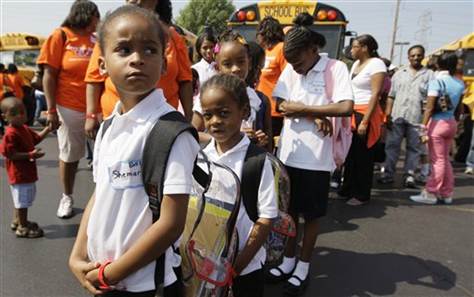American Public School Students Going Hungry?
The Huffington Post column “Michelle Obama’s Low-Calorie School Lunches Slammed By ‘Hungry’ High Schoolers” reports, “Michelle Obama’s childhood obesity initiative has been the subject of conservative criticism for some time, and now there’s another group joining in on the attack.”
The group that HuffPo is referring to are public school students, whose video titled “We Are Hungry” [watch below] about school lunches has gone viral.
The video beings with the statement – Active teens require between 2,000 and 5,000 calories a day to meet energy and growth needs (“A Guide to Eating for Sports“).
According to Beverly L. Girard, PhD, MBA, RD, Director of Food and Nutrition Services for Sarasota County Florida Schools, “President Harry S. Truman signed the National School Lunch Act on June 4, 1946. Though school food service began long before 1946, the Act authorized the National School Lunch Program. The legislation came in response to claims that many American men had been rejected for World War II military service because of diet-related health problems [recruits were undernourished]. The federally assisted meal program was established as ‘a measure of national security, to safeguard the health and well-being of the Nation’s children and to encourage the domestic consumption of nutritious agricultural commodities’.”
Upon signing the National School Lunch Program legislation President Truman stated, “Despite our capacity to produce food we have often failed to distribute it as well as we should … Congress has contributed immeasurably both to the welfare of our farmers and the health of our children.”
Have we met, if not surpassed, the initial legislative intent of Congress? Do we need government to be concerned about those volunteering for our military services having diet-related health problems? Do we need to be concerned about the redistribution of food given our nation wide system of grocery store chains? Is government the best determiner of a child’s eating habits? Do taxpayers need to provide welfare for farmers?
 Many citizens are questioning governments expanding role in the free and reduced lunch program as amended by the Health and Hunger-Free Act of 2010. The new guidelines — the first major overhaul of school meals in 15 years — mandate public school cafeterias serve less fat and sodium and more fruits, vegetables and whole grains.
Many citizens are questioning governments expanding role in the free and reduced lunch program as amended by the Health and Hunger-Free Act of 2010. The new guidelines — the first major overhaul of school meals in 15 years — mandate public school cafeterias serve less fat and sodium and more fruits, vegetables and whole grains.
Taxpayers are also questioning the growing number of students on free and reduced lunches. Sarasota County, one of the wealthiest counties in Florida, has 50.37% of students in the district currently eligible for free or reduced price meals according to Dr. Girard.
Dr. Girard notes, “The determining body for the revised USDA meal pattern was the Institute of Medicine, chaired by Virginia Stallings, MD, The Children’s Hospital of Philadelphia, University of Pennsylvania.” Why does one institution have such power in determining what and how much children should eat?
The lunch caloric ranges for students are: elementary students – 550-650 calories; middle school students – 600 to 700 calories and high school students – 750 to 850 calories. Dr. Girard states, “If a child eats lunch at school for the 180 days of the school year, they receive about 16.4% of the meals they eat in a year at school. Sarasota school lunches represent adequate portion size and nutritional balance.”
Michelle Obama is concerned about obesity in America. It appears that the free and reduced lunch program’s initial intent to address the diet-related health problems of our draftees is no longer needed. Perhaps it is time to reconsider the need for this federal program?
If obesity is a problem then is there an over redistribution of food in America?
 Is this the the American version of Hunger Games?
Is this the the American version of Hunger Games?
“In a country where the sole employer is the State, opposition means death by slow starvation. The old principle: who does not work shall not eat, has been replaced by a new one: who does not obey shall not eat.” ― Leon Trotsky.
Leon Trotsky was a Bolshevik revolutionary and Marxist theorist. He was one of the leaders of the Russian October Revolution in 1917, second only to Vladimir Lenin. During the early days of the Soviet Union, he served first as People’s Commissar for Foreign Affairs and later as the founder and commander of the Red Army and People’s Commissar of War. He was also among the first members of the Politburo.
RELATED VIDEO: “We Are Hungry” done by students from Wallace County High School in Sharon Springs,Kansas.


